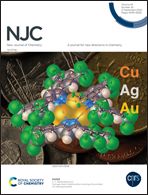A good-performance glucose sensor fabricated via rationally designing a new cobalt–metal–organic framework precursor†
Abstract
A good-performance glucose sensor based on Co3O4 has been first synthesized by rationally designing a new cobalt–metal–organic framework precursor, having the structural formula of [Co(Cia)2(bmb)]n (Cia = 5-((4-carboxybenzyl)oxy)isophthalic acid, bmb = 1,4-bis(2-methylbenziidazol-1-ylmethyl)benzene). The Co-MOF precursor exhibits one-dimensional chains in molecular structures, which are further extended to form a 3D framework via hydrogen bonds. The Co-MOF crystals show a separated columnar shape and are further stacked into micro-flower clusters. Then, the micro-flower clusters of Co-MOF precursors are transformed into Co3O4 with a curved sheet morphology by treatment at 450 °C in air. The Co3O4-modified glassy carbon electrode (Co3O4/GCE) is applied as a glucose sensor, which works well both at a low glucose concentration range of 0.001–2 mM and high concentration range of 2–8 mM with sensitive sensitivities of 254.21 μA mM−1 cm−2 and 102.80 μA mM−1 cm−2, respectively. Moreover, Co3O4/GCE exhibits good anti-interference, reproducibility and stability. This study aims to not only provide an example to fabricate Co3O4 with diverse morphologies but also affords a strategy to explore more effective electrode materials as high-performance electrochemical sensors.



 Please wait while we load your content...
Please wait while we load your content...